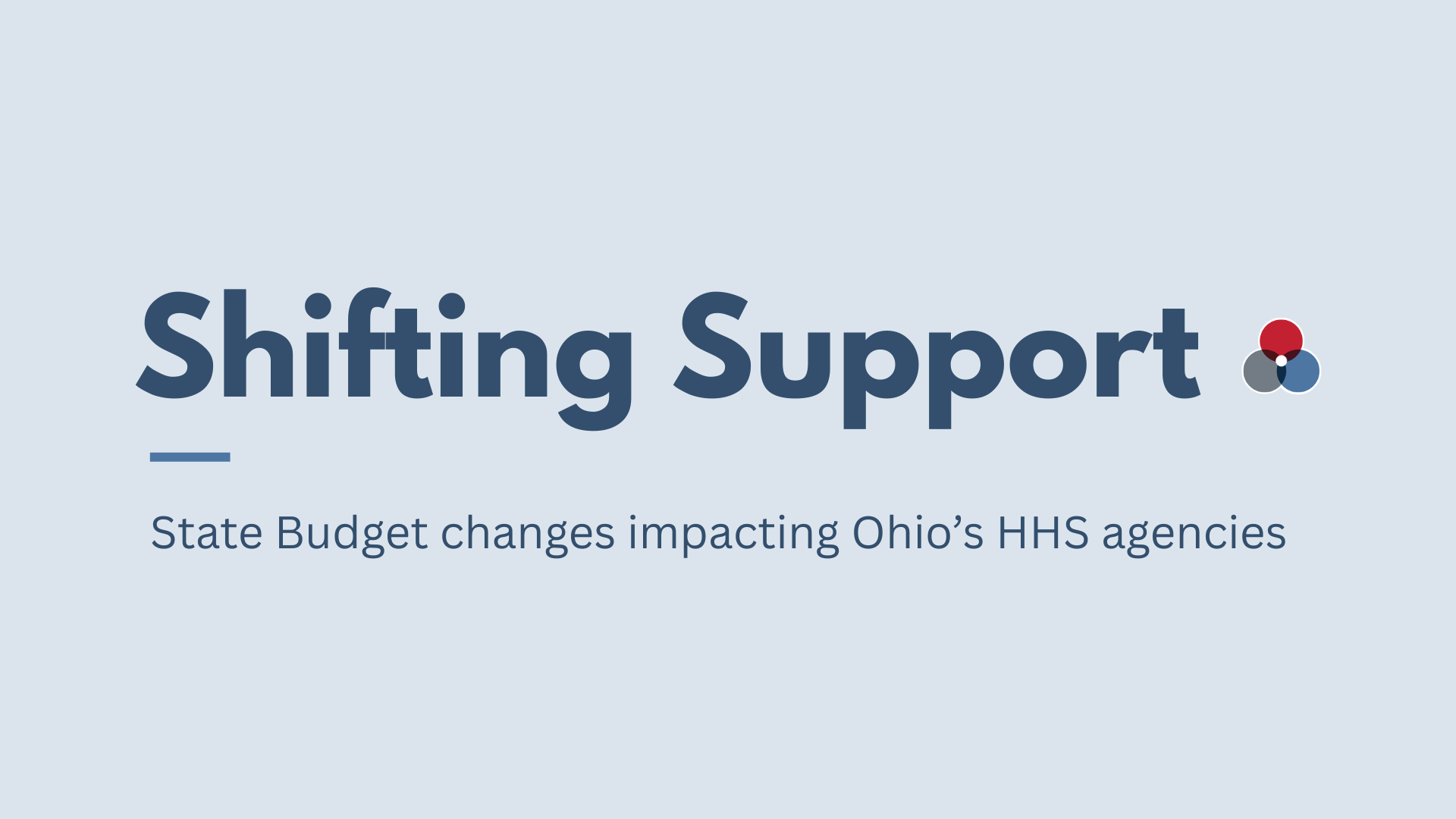September 8, 2020
HIGHLIGHTS
- To date, the federal government has allocated $10 billion in COVID-19 grant funding to Ohio. Individuals and businesses in the state have directly received much more federal support.
- Nearly one-half of all federal grant funding, or $4.5 billion, has come through the Coronavirus Relief Fund in the CARES Act. The state’s six largest local governmental units received these funds directly, including $215.5 million provided to Cuyahoga County.
- Most of the remaining federal grant funds will be used to support health and human service priorities ($3.4 billion), including hospitals and skilled nursing facilities, child care assistance, and support for the Ohio Department of Health and local health districts.The U.S. Congress has enacted three federal supplemental appropriation bills in response to the COVID-19 pandemic: the Coronavirus Preparedness and Response Supplemental Appropriations Act (P.L. 116-123), the Families First Coronavirus Response Act (P.L. 116-127), and the Coronavirus Aid, Relief and Economic Security, or CARES Act (P.L. 116-136). There are additional appropriation bills pending in Congress on the COVID-19 response that are not law as of this time, notably the Health and Economic Recovery Omnibus Emergency Solutions, or HEROES Act (H.R. 6800) that was passed by the U.S. House of Representatives in May 2020.
The Appendix to this report provides detail on existing federal COVID-19 grants to the State of Ohio and its political subdivisions.[1] The data includes funding from the three enacted statutes to date. It does not include non-grant money, such as Paycheck Protection Program funds, that were paid directly to individuals nor does it include Economic Injury Disaster Loans made to businesses. It also does not include appropriations contained in legislation still pending in Congress.
Ohio has received nearly $10.0 billion from the total U.S. COVID-19 grant funding.
Coronavirus relief funds
As of September 1, 2020, Ohio has received nearly $10.0 billion from the total U.S. COVID-19 grant funding of more than $351.5 billion, which represents 2.84 percent. This funding percentage is somewhat less than Ohio’s 3.54 percent share of the country’s population. Nearly half of Ohio’s total allocation of COVID-19 grant aid, or more than $4.53 billion, came from the U.S. Department of the Treasury through the CARES Act. These funds were distributed directly to local governments with populations of 500,000 or more, with the balance of funding going to the state for subsequent distribution to other local governmental units in Ohio. Local distributions included:
- City of Columbus - $156.8 million
- Franklin County (excepting the City of Columbus) - $76.3 million
- Cuyahoga County - $215.5 million
- Hamilton County - $142.6 million
- Montgomery County - $92.8 million
- Summit County - $94.4 millionThe payment for the balance of the state, i.e. for Ohio’s 83 other counties and their communities, was more than $3.75 billion. Table one depicts the distribution of Coronavirus Relief Fund money made directly to Ohio’s largest local governments.
Table 1: Coronavirus Relief Fund Direct Allocations to Ohio Localities

Coronavirus Relief Fund money can be used to cover any necessary expenses related to the COVID-19 pandemic that were not accounted for in a government’s budget. Plans are still being finalized for the use of these funds in most jurisdictions. These plans were likely delayed because the funds cannot be used as a revenue replacement or for items already included in a jurisdiction’s budget.
The City of Columbus has determined a proposed use of all of its nearly $157 million in funding. The majority of funding, $80 million, will be dedicated to spending on COVID-19-related items, such as testing, EMS response and personal protective equipment (PPE). Of the balance, $51 million will be allocated for human services, such as shelter for those experiencing homelessness, and for food and rental assistance. The remaining $26 million is for economic impact, such as small business assistance and technology for teleworking.
Cuyahoga County Council approved more than $85 million in spending to date from its $215.5 million allocation.
Through August 11, the Cuyahoga County Council had approved more than $85 million in spending to date from its $215.5 million allocation. The largest sum, $30 million, will be spent on building retrofits and updates required for social distancing. Much of the balance will be dedicated to COVID-19 testing, emergency health screening, personal protective equipment, deep cleaning and other mitigation services, as well as to hazard pay and reimbursement of employee emergency leave. Support for landlords owed lost tenant income and other eviction prevention services will be other priority items as will housing for unemployed, underemployed, and/or homeless residents. In addition, some funding has been authorized for small business stabilization, technology to expand remote working capacity, and virtual job fairs.
Grant funding from other U.S. departments
Nearly all of the balance of Ohio’s COVID-19 grant funding, more than $5.45 billion, came through nine separate U.S. Cabinet-level agencies. The majority of this funding was from the U.S. Department of Health and Human Services ($3.39 billion), although substantial funding also came from the U.S. Department of Education ($1.03 billion), the U.S. Department of Transportation ($587 million), and the U.S. Department of Housing and Urban Development ($292 million). COVID-19 funding from other federal departments included:
- Labor - $47.1 million
- Agriculture (USDA) - $43.6 million
- Justice - $24.4 million
- Commerce - $18.0 million
- Homeland Security - $13.4 millionIn addition, nearly $13 million in COVID-19 funding was made available to Ohio for Election Security Grants for federal elections and more than $2.3 million was provided for arts and humanities from other independent agencies of the federal government as follows:
- Institute of Museum and Library Services - $1.1 million
- National Endowment for the Humanities - $ 0.8 million
- National Endowment for the Arts - $0.5 millionChart one depicts the sources of funding for the various federal departments and independent agencies, including the Coronavirus Relief Fund of the U.S. Department of the Treasury.
Chart 1: Ohio Grant Funding Allocation by U.S. Department

U.S. Department of Health and Human Services
Chart two depicts where the $3.39 billion in funding that Ohio received from the U.S. Health and Human Services came from.
Chart 2: U.S. Department of Health and Human Services Allocation to Ohio

The lion’s share of Ohio’s funding from the U.S. Department of Health and Human Services was Provider Relief Funds from its Office of the Secretary ($2.75 billion). Provider Relief Funds will be used to support the considerable strain that the COVID-19 pandemic has placed on Ohio’s hospitals and skilled nursing facilities.
Provider Relief Funds will be used to support the considerable strain that the COVID-19 pandemic has placed on Ohio’s hospitals and skilled nursing facilities.
Support for the Centers for Disease Control and Prevention, or CDC, in Ohio totaled more than $285 million. The state can use these funds for grants and cooperative agreements with and between local health districts and other local entities to carry our surveillance; epidemiology; laboratory capacity; infection control; mitigation; communications; and other preparedness and response activities.
Much of the remaining health and human services funding went to support several activities of the Administration for Children and Families. More than half of the $227 million this office received, or $117 million, is contained in a Child Care and Development Block Grant. These funds will assist child care providers who saw decreased enrollment due to the COVID-19 pandemic. Funds can be used to pay staff salaries and wages, and also for cleaning supplies and services necessary to maintain operations. They can also be used to provide child care services to workers deemed essential to the COVID-19 response.
Other priorities funded under the auspices of the federal Administration for Children and Families included:
- Community Services Block Grant - $ 39.0 million
- Low-Income Home Energy Assistance - $37.7 million
- Head Start - $ 29.6 million
- Child Welfare Services - $1.7 million
- Family Violence Prevention - $1.3 million
- Runaway and Homeless Youth - $0.7 millionPrograms under the Health Resources and Services Administration ($70.8 million), the Administration for Community Living ($42.4 million), and the Substance Abuse and Mental Health Services Administration ($7.6 million) also received funding that will support activities in Ohio. Among many other services, this funding will support community health centers, including expanding the capacity for COVID-19 testing, the Ryan White HIV/AIDS program, and to provide home-delivered and congregate meals.
U.S. Department of Education
The $1.03 billion that Ohio received in funding from the U.S. Department of Education was broken down into three broad areas. The largest share, $489.2 million, was targeted for elementary and secondary school emergency relief grants. These funds can be used for a broad range of COVID-19 needs as well as other purposes authorized by the Elementary and Secondary Education Act (ESEA).
Nearly as much support was provided to Ohio’s public and private higher education institutions ($406.4 million). The bulk of this money, $395.6 million, was aimed at covering costs associated with the significant instructional changes due to COVID-19, as well as to provide emergency financial aid grants to students for expenses related to the crisis. At $42.9 million, The Ohio State University received the largest share of funding from this source. No other Ohio institution received more than $20 million. In addition to this more general support, $10.8 million was to support Ohio’s Historically Black Colleges and Universities (HBCUs), Central State University and Wilberforce University, and a few other designated minority serving institutions (MSIs), such as the Union Institute & University in Cincinnati.
An additional $25.1 million was provided to Ohio to address areas that the Secretary of Education determined have the greatest need related to the COVID-19 pandemic.
An additional $25.1 million was provided to Ohio to address areas that the Secretary of Education determined have the greatest need related to the COVID-19 pandemic.
Finally, Ohio received $104.9 million from the Governor's Emergency Education Relief (GEER) Fund, to local education agencies, higher education institutions, and other education-related entities that the state deems to be most impacted by COVID-19.
Table two depicts education funding by functional category.
Table 2: U.S. Department of Education Allocation to Ohio

Other programs
With a comparatively undeveloped public transit system and limited Amtrak service, Ohio received little overall funding from the U.S. Department of Transportation ($586.8 million or 1.7 percent of the total funds allotted) when compared to its population base. Support from the Federal Transit Administration will be distributed throughout Ohio to both urbanized and nonurbanized areas on a formula basis. The $478.0 million in funding will be used for transit agency operating expenses impacted by the COVID-19 emergency, such as the purchase of personal protective equipment and paying for administrative leave caused by service reductions for personnel. In addition, grants to meet the infrastructure and other needs of Ohio airports was funded at $108.8 million.
Grants to meet the infrastructure and other needs of Ohio airports was funded at $108.8 million.
A final area worth noting is the $292.4 million in funding provided to the state through the U.S. Department of Housing and Urban Development. This funding will support Community Development Block Grants ($128.4 million), Emergency Solution Grants for the homeless ($105.0 million), tenant-based rental assistance ($26.4 million), public housing ($29.7 million), and housing opportunities for people with disabilities ($1.9 million) and people with AIDS/HIV ($0.9 million).
Summary
The State of Ohio and its political subdivisions have been authorized to receive nearly $10 billion in COVID-19 grant funding to date. Some of this funding has not yet been disbursed and spent. Coronavirus Relief Fund moneys are available for expenditure until December 30, 2020. Other federal COVID-19 grant programs have varying dates for which funds must be obligated, but the majority of these grants will not expire until September 30, or December 30, 2021 and in a few cases, not until the end of 2022.
Even more federal resources have been authorized in terms of non-grant funding through the Paycheck Protection Program, Economic Injury Disaster Loans, food assistance, and other initiatives. Through August 8, $18.5 billion had been provided to Ohioans through the Paycheck Protection Program, and as of August 24, another $4.5 billion had been provided in Economic Injury Disaster Loans and loan advances.
COVID-19 funding falls short of what is required to address the needs of Ohio’s public institutions and citizens.
Despite this substantial investment, COVID-19 funding falls short of what is required to address the needs of Ohio’s public institutions and citizens. The $3 trillion HEROES Act would provide some critical elements missing in the appropriation bills enacted thus far. Most notably perhaps would be the $875 billion in total funding it would provide for state fiscal stabilization, $500 billion for state governments and $375 billion for local governments. Similar stimulus aid was a critical piece to lift America out of the Great Recession a decade ago.
The author wishes to acknowledge Michael Kohler, Policy Intern, for his considerable assistance with the data and related graphics contained in this report.
[1] The data is as of September 1, 2020 from Federal Funds Information for States (FFIS) (www.ffis.org). FFIS was founded as a joint collaboration of the National Governors Association and the National Conference of State Legislatures to help states manage their federal funds by analyzing the impact of federal actions on states.
Appendix: Federal COVID-19
Grant Funding to Ohio[i]
(Dollars in millions)Ohio Total: $9,984.7 US Total: $351,502.8
Treasury
(P.L. 116-136, Div. A Title V)Ohio Coronavirus Relief Fund (CARES ACT)Ohio Allocation: $4,532.6 US Total Allocation: $150,000.0 For more information click here
Columbus City - $156.8
- $80.0 in direct spending for COVID-19 expenses such as testing, EMS response and personal protective equipment (PPE)
- $51.0 for human services such as shelter for those experiencing homelessness, and for food and rental assistance
- $26.0 for mitigating the negative economic impact for things like small business assistance and technology for teleworking
Franklin County (balance of) - $76.3
Cuyahoga County - $215.5
Hamilton County - $142.6
Montgomery County - $92.8
Summit County - $94.4
Payment to (balance of) state - $3,754.1
Health and Human Services
Ohio Allocation: $3,385.7
US Total Allocation: $106,538.9
Administration for Children and Families
Ohio Allocation: $227.4
US Total Allocation: $6,248.7
P.L. 116-136, Div. B Title VIII)Child Care and Development Block Grant - $117.4 (https://www.acf.hhs.gov/occ/resource/2020-cares-act-ccdbg-supplemental-funding-allocations-for-states-and-territories) Community Services Block Grant - $39.0 Low Income Home Energy Assistance Program - $37.7 Family Violence Prevention - $1.3 Child Welfare Services - $1.7 Runaway and Homeless Youth (RHY): Basic Centers - $0.3 Runaway and Homeless Youth (RHY): Transitional Living for Homeless Youth - $0.3 Runaway and Homeless Youth (RHY): Education and Prevention Grants - $0.1 Head Start - $29.6
Administration for Community Living
Ohio Allocation: $42.4
US Total Allocation: $1,175.0
(P.L. 116-127, Div. A Title V)Congregate Meals - $2.9 Home-Delivered Meals - $5.9
(P.L. 116-136, Div. B Title VIII)Home-Delivered Meals - $17.6 Supportive Services - $7.3 Family Caregivers - $3.6 Protection of Vulnerable Older Americans - $0.7 Aging and Disability Resource Centers - $1.7 Centers for Independent Living - $2.5
Centers for Disease Control (CDC)
Ohio Allocation: $285.1
US Total Allocation: $12,848.0
(P.L. 116-123, Div. A Title III)CDC Grants (to date) - $24.9
(P.L. 116-136, Div. B Title VIII)CDC Grants (to date) - $21.8
(P.L. 116-139, Division B Title I)CDC Testing Funds - $238.4
Health Resources and Services Administration (HRSA)
Ohio Allocation: $70.8
US Total Allocation: $2,510.8
(P.L. 116-136, Div. A Title VIII)Ryan White HIV/AIDS - Part A - $0.7 Ryan White HIV/AIDS - Part B - $ 0.6 Ryan White HIV/AIDS - Parts C, D, F - $0.7 Community Health Centers - $3.2
(P.L. 116-136, Div. B Title VIII)Poison Control Centers - $0.2 Community Health Centers - $40.7 Small Rural Hospital Improvement Program - $3.1 Geriatrics Workforce Enhancement Program - $0.1 Area Health Education Centers Program - $0.1 Registered Nurses in Primary Care Training Program - $0.2
(P.L. 116-139, Division B Title I)Community Health Centers - Expanding Capacity for Coronavirus Testing - $17.5 Health Center Look-Alikes - Expanding Capacity for Coronavirus Testing - $0.7 Rural Health Clinics - COVID-19 Testing - $2.8
Substance Abuse and Mental Health Services Administration (SAMHSA)
Ohio Allocation: $7.6
US Total Allocation: $399.2
(P.L. 116-136, Div. B Title VIII)Emergency Grants to Address Mental and Substance Use Disorder - $2.0 Emergency Response for Suicide Prevention - $1.6 Certified Community Behavioral Health Clinics - $4.0
Office of the Secretary
Ohio Allocation: $2,752.5
US Total Allocation: $83,357.2
(P.L. 116-136, Div. B Title VIII)Provider Relief Funds - General Allocations (to date)- $989.8 (https://ffis.org/sites/default/files/public/first%5Fphssef%5Fdistribution%5Fsummary%5Fby%5Fstate%5F-%5F2020-04-10.pdf) Provider Relief Funds - High-Impact (to date) - $283.7 Provider Relief Funds - Rural (to date) - $396.0 Provider Relief Funds - Skilled Nursing Facilities (to date) - $450.0 Provider Relief Fund -Safety Net Hospital Distribution (to date) - $622.2 Hospital Preparedness (to date) - $10.7
Education
Ohio Allocation: $ 1,025.6
US Total: 30,383.9
(P.L. 116-136, Div. B Title VIII)Governor's Fund - $104.9 (https://oese.ed.gov/governors-emergency-education-relief-fund/) K-12 Fund - $489.2 (https://oese.ed.gov/offices/education-stabilization-fund/elementary-secondary-school-emergency-relief-fund/) Higher Education Fund - General - $395.6 (https://www2.ed.gov/about/offices/list/ope/caresact.html) Higher Education Fund - HBCUs/MSIs - $10.8 (https://www2.ed.gov/about/offices/list/ope/caresact.html) Higher Education Fund - Unmet Needs - $25.1 (https://www2.ed.gov/about/offices/list/ope/caresact.html)
Labor
Ohio Allocation: $47.1
US Total Allocation: $1,349.3
(P.L. 116-127, Div. D Sec. 4102)UI (Unemployment Insurance) Administration - $17.6 UI Administration (Supplemental) - $17.6
(P.L. 116-136, Div. A, Sec. 2108)Short-Time Compensation - $3.5
(P.L. 116-136, Div. B Title VIII)Dislocated Worker Grants (to date) - $8.5
Agriculture (USDA)
Ohio Allocation: $43.6
US Total Allocation: $1,350.0
(P.L. 116-127, Div. A Title I)Emergency Food Assistance Program (TEFAP) - $15.1
(P.L. 116-136, Div. B Title I)Emergency Food Assistance Program (TEFAP) - $17.1
( P.L. 116-127, Div. A Title I)Supplemental Nutrition Program for Women, Infants, and Children (WIC) - $11.4
Justice
Ohio Allocation: $24.4
US Total Allocation: $850.0
(P.L. 116-136, Div. B Title II)Justice Assistance Grants - State - $16.0 (https://bja.ojp.gov/funding/opportunities/bja-2020-18553) Justice Assistance Grants - Local - $8.5 (https://bja.ojp.gov/funding/opportunities/bja-2020-18553)
Homeland Security
Ohio Allocation: $13.4
US Total Allocation: $16,784.6
(P.L. 116-136, Div. B Title VI)Emergency Performance Management Grant- $2.9 Emergency Food and Shelter Program (EFSP)- $8.3 Assistance to Firefighters Grant (AFG) Program- $2.2
Commerce
Ohio Allocation: $18.0
US Total Allocation: $992.3
( P.L. 116-136, Div. B Title II)Economic Adjustment Assistance (EAA) - Economic Development Districts (to date) - $2.0 EAA - University Centers (to date) - $0.6 EAA - Revolving Loan Fund Capitalization (to date) - $14.8 Manufacturing Extension Partnership (MEP) - $0.6
Housing and Urban Development
Ohio Allocation: $292.4
US Total Allocation: $8,629.0
(P.L. 116-136, Div. B Title XII)Community Development Block Grant (CDBG) - Local (to date) - $63.7 CDBG - State (to date) - $64.8 Emergency Solutions Grants (ESG) - Local - $57.6 ESG - State - $47.3 Public Housing Operating Fund - $29.7 Tenant-Based Rental Assistance - Administrative Fees - $26.4 Supportive Housing for Persons with Disabilities (Sec. 811) - $1.9 Housing Opportunities for Persons with AIDS - $0.9
Transportation
Ohio Allocation: $586.8
US Total Allocation: $34,034.7
(P.L. 116-136, Div. B Title XII)FTA (Federal Transit Administration) Urbanized Formula - $396.1 FTA Nonurbanized Formula - $81.9 Grants-in-Aid for Airports - $108.8
Independent Agencies
Ohio Allocation: $15.1
US Total Allocation: $490.0
(P.L. 116-136, Div. B Title V)Election Security Grants - $12.8
(P.L. 116-136, Div. B Title VIII)Institute of Museum and Library Services - $1.1(P.L. 116-136, Div. B Title VII)National Endowment for the Arts - $0.5 National Endowment for the Humanities - $0.8
[i] Data is from Federal Funds Information for States (FFIS) (www.ffis.org) as of September 1, 2020 unless otherwise noted. FFIS was founded as a joint collaboration of the National Governors Association and the National Conference of State Legislatures.








